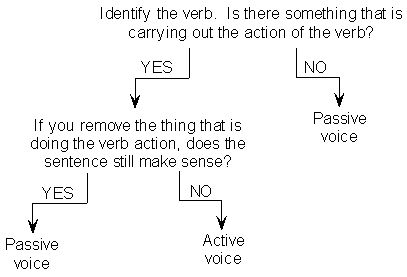Passive voice
When a sentence is in the passive voice, something is being done to the subject, instead of the subject doing something. The subject receives the verb action when the sentence is in the passive voice. Have a look at this sentence:
The experiment was run for 15 minutes.
So the subject of the sentence is clearly ‘the experiment’. Is the experiment doing anything - no. Is the experiment having anything done to it - yes! It’s being ‘run’.
Now, normally when we see a noun that is having something done to it, we’d say - well it’s the object of the sentence. This is where the passive voice comes in. When the sentence describes how the subject is having something done to it, this is the passive voice. Because of the way the sentence is structured, the subject doesn’t become the object, even though it’s having something done to it.
Let’s compare the active and passive versions of this sentence:
Passive:
The experiment was run for 15 minutes.
Active:
We ran the experiment for 15 minutes.
The passive version describes how the experiment is having something done to it - it’s being run. In this case, ‘experiment’ is still the subject of the sentence.
The active version describes how we did something to the experiment - we ran it. It describes directly how something was done to the experiment, rather than indirectly in the passive version.
Another way of working out whether a sentence is in the passive or active voice is to go through this process:

Try it on this sentence:
The experiment was run for 15 minutes by John.
The verb is ‘was run’. Is there something that carried out this verb? Yes - in this case John is the thing that ran the experiment. So we go down the left-hand side of the diagram. Next question!
Can we remove the thing that is doing the verb action - in this case, ‘John’. So can we remove the ‘by John’ bit?
The experiment was run for 15 minutes. by John.
The sentence still makes sense. So the sentence is in the passive voice, and the verb ‘was run’ is a passive verb. Let’s try another sentence:
Sally ran the experiment for 15 minutes.
First step, identify the verb - it’s ‘ran’. Now, is there something that carried out or performed this verb - yes! Sally was the thing that carried out the verb action. Next stage!
Can we remove the thing that is doing the verb action - ‘Sally’ in this case?
Sally ran the experiment for 15 minutes.
Nope! The sentence doesn’t make sense. This means the sentence is in the active voice. This is a general characteristic of active sentences - the person or thing that is doing the verb action has to be in the sentence. Passive sentences, on the other hand, don’t require the doer of the verb to be in the sentence (although they can be). Usually, to add the doer of the verb into a passive sentence we add a ‘by ...’ part in:

My Microsoft Word grammar checker always asks me whether I really want my sentences to be in the passive voice. There are some situations, like writing science reports, when it is useful to write in the passive voice. This is because the passive voice can place an emphasis on what is being done, rather than who is doing it. The sample sentence above is an example of this. It’s not really important who ran the experiment. What’s important is that it ‘was run for 15 minutes’.
Click here to move on to the next topic: How to write in the passive voice